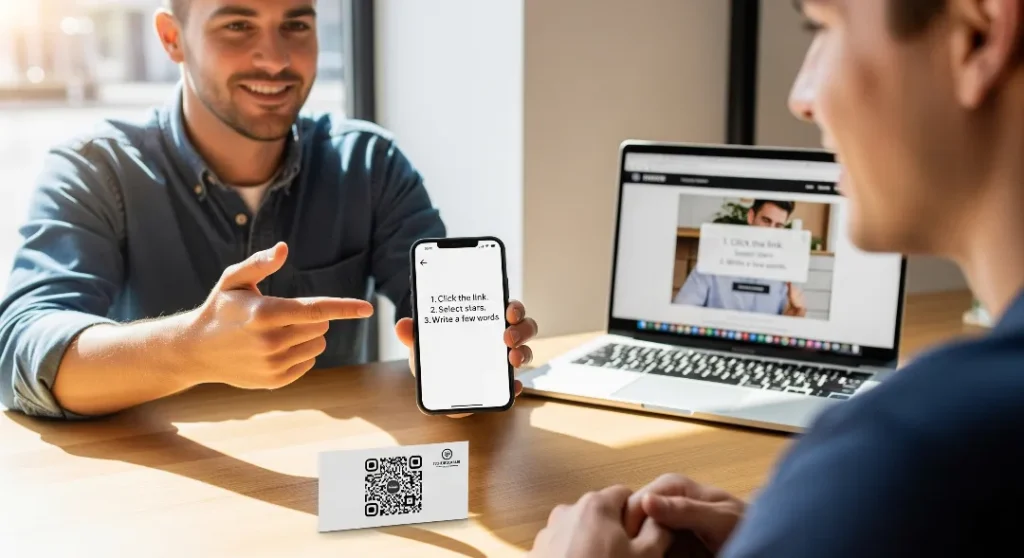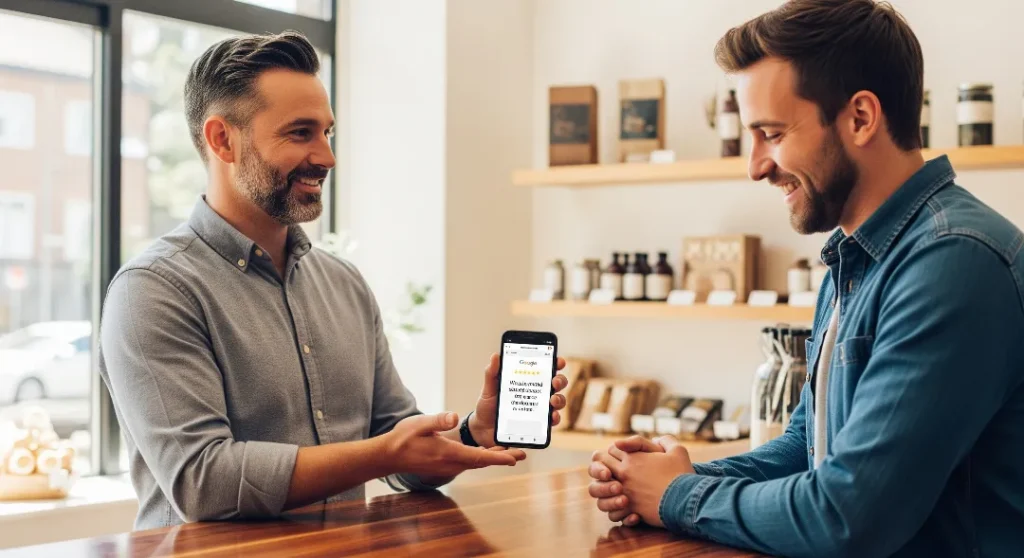
Getting local business reviews doesn’t have to feel awkward, salesy, or pushy. In fact, when done the right way, asking for reviews feels like a natural extension of great customer service. Think of it this way: if someone leaves your store with a smile, or finishes a service and says, “Wow, that was amazing!”—that’s the perfect moment to capture their feedback.
But here’s the catch: most businesses don’t ask, or they ask in needy-sounding ways—like begging or bribing. Customers can smell that a mile away, and it tends to backfire. The good news? There are smart, simple strategies that not only bring in more reviews but also make your review credibility shine and get you found in local search results.
In this guide, we’ll cover everything you need to know about review generation tips—from timing your ask to making it easy, ethical, and effective. By the end, you’ll know exactly how to get reviews without feeling pushy.
Why Local Reviews Matter for Your Business

Local reviews are not just stars on a page—they are the lifeblood of your reputation. Consumers today do not just rely on ads; they rely on each other. If your business has continually positive reviews, it is like having a queue of happy customers endorsing you 24/7.
Even better, websites like Google have begun utilizing these reviews to rank businesses in local search results. So the more quality reviews you have, the more visible you are to new customers searching online.
The role of reviews in local SEO and visibility
Google and other search engines prefer Google Business Profile reviews to decide which companies should get the limelight. Reviews serve as trust signals. A consistent stream of genuine feedback enhances your local map pack ranking, making your business more visible and providing a competitive advantage.
How customer reviews establish credibility and trust
Think of reviews as the new word of mouth. A 5-star review communicates to potential customers, “This place is legit.” And if reviews include details about real experiences, they act like mini testimonials, building instant credibility with reviews.
When and How to Ask for Reviews
Asking for a review is all about timing and channel. Ask too soon, and customers might not have had a full experience. Wait too long, and the moment of excitement fades. The key is finding that sweet spot when the customer feels happiest.

Not every customer prefers the same communication method either. Some love email, others prefer a quick WhatsApp, while many still appreciate an old-school printed card. Matching your approach to their preference makes all the difference.
Asking at the right time
The best time? Right after a positive experience. Did a customer compliment your service? Did they say, “I’ll definitely come back”? That’s your green light. The fresher the experience, the more likely they’ll leave a detailed review.
Using the right channel for each customer
Not all customers email, and not everyone likes texts. Pay attention to where your customer engages most. An online-first purchaser? Email them. A repeat? Text them a personal message. A walk-in? Provide them with a review card.
Email requests for online orders
For e-commerce and service-based businesses, email is often the most effective channel. Sending an automated email 24–48 hours after the purchase gives customers time to experience the product or service, while the interaction is still top of mind.
The key is to keep the message short and genuine. Thank them for their order, invite them to share their thoughts, and include a direct link to your Google review page. The easier you make it, the more likely they’ll click through.
SMS or WhatsApp for repeat customers
For loyal or repeat customers, SMS and WhatsApp feel more personal and immediate than email. A short message like, “Thanks for visiting today! Could you share your experience on Google?” comes across as friendly rather than pushy.
Since these customers already know and trust your business, they’re more likely to respond positively to a direct message. Keep it brief, respectful, and always include a link so they can leave a review in just one tap.
Printed cards or in-person requests for local customers
For physical stores, there is nothing like a simple card with your Google Business Profile review link. Pair it with a friendly smile and a “We’d appreciate your feedback.” It sounds personal without being invasive.
Best Practices for Review Generation

Review requests only work if they’re easy, respectful, and non-intrusive. Customers shouldn’t have to click through ten pages or feel like you’re pestering them. The goal is to remove friction and make leaving a review effortless.
When you’re requesting, don’t make it complicated. The easier you make it, the better chance you have of success. Always remember: the customer is doing you a favor, so turn it into a thank-you opportunity.
Make customers’ lives simple by making it simple to review
If the process feels like a chore, most customers won’t bother. Convenience is key. Instead of expecting them to search for your business or figure out where to write a review, provide them with a direct path.
- Use direct review links: Generate a Google review link from your Google Business Profile and share it with customers right after their visit or service.
- Leverage multiple channels: Add the link to thank-you emails, SMS follow-ups, or even your website’s footer.
- Integrate review requests into checkout: For in-person businesses, consider adding a QR code on receipts or at the front desk.
Think of it this way: the fewer steps between a happy customer and a posted review, the higher your conversion rate.
Make it simple with direct links or step-by-step instructions
Even if customers are willing to leave a review, some may feel uncertain about the steps. That’s why clear guidance matters.

- Step-by-step prompts: In your email or SMS, add a line like: “Click the link below, select the number of stars, and share a few words about your experience.”
- Clickable buttons & QR codes: Make the call-to-action visually obvious. For print materials, QR codes are ideal—customers just scan and go.
- Consistency across platforms: Use the same direct link on social media, your website, and business cards so customers don’t get lost.
By simplifying the process, you’re reducing hesitation and making reviews almost automatic.
Be considerate of privacy and avoid spammy requests
Customers appreciate being asked for feedback—but not when it feels forced or relentless. A respectful approach builds trust, while aggressive reminders risk damaging your reputation.
- One gentle follow-up is enough: If they don’t respond to the first request, it’s best to let it go. Anything more feels pushy.
- Timing matters: Send your request when the customer is most satisfied—right after a successful service, a positive interaction, or a completed purchase.
- Honor customer preferences: If someone opts out of emails or SMS, don’t bypass their choice with another method.
Remember, a review is a gift. Treat it as such—by showing gratitude and not pressure.
Tips to Ask Without Sounding Desperate

How you ask is equally as crucial as when you ask. Customers can sniff out a canned, robotic message from a mile away. So, use their own words, make it personal, and sound natural.
By sounding conversational and genuine, you’re showing that you care about their opinion rather than just stars.
Let the customer’s words guide the ask
One of the easiest ways to make your review request feel genuine is to build on what the customer has already said. If they compliment your service or mention something positive—like, “This was amazing”—you can turn that into an opportunity.
A simple response such as, “That means so much! Would you mind sharing those exact words in a quick Google review?” feels natural because it comes directly from their own experience. You’re not pushing them; you’re inviting them to repeat what they already expressed, which makes the request seamless and authentic.
Make the request specific to each client
Generic messages often feel cold and robotic, so tailoring your request goes a long way. Instead of sending the same copy-and-paste line to everyone, reference something specific about their visit or purchase. For example: “Thanks for choosing us for your teeth whitening today.
Your feedback would really help others looking for the same service.” By tying the request to their actual experience, you make the message more personal, meaningful, and much harder to ignore. This small effort shows that you remember them as an individual, not just another transaction.
Be sincere and conversational in tone
No one enjoys reading stiff, corporate-sounding requests. The best way to ask for a review is to keep your tone light, friendly, and approachable—almost like you’re talking to a friend. Avoid jargon, buzzwords, or overly formal phrasing that feels forced.
A short, warm message such as “We’d love to hear how your visit went—it really helps others!” makes you relatable and approachable. When customers feel like they’re talking to a real human rather than a scripted robot, they’re more likely to respond positively and leave a review.
Ethical and Effective Review Generation Tips

Review generation should never feel sleazy. Artificial reviews, buying stars, or incentivizing reviews may give you a short-term boost but will destroy your reputation in the long run. Instead, attempt authentic methods that naturally encourage feedback.
When reviews are executed properly, they not only improve SEO but also foster a stronger connection with real customers.
What not to do (fake reviews, incentives, spam)
It can be tempting to take shortcuts when trying to build your reviews, but this almost always backfires. Buying reviews, using fake accounts, or offering discounts in exchange for reviews is against Google’s policies and can result in serious penalties, including the removal of your reviews or even suspension of your profile.
Beyond the risks with Google, customers are savvy—they can often spot fake, overly generic, or suspiciously glowing reviews. Nothing damages trust faster than being caught manipulating feedback.
Instead of chasing numbers, focus on earning genuine reviews by delivering excellent service and asking in an honest way. Authentic reviews may take longer to build, but they carry far more weight with both potential customers and search engines.
Automate requests without sounding robotic
Use tools like CRM systems to automate review requests, but personalize the message always. A “Thank you, [Name]” goes a long way in making it personal.
Highlight positive reviews to receive more
Once you’ve collected authentic reviews, don’t let them sit unseen—put them to work. Highlighting customer feedback on your website, in-store signage, or across your social media channels not only builds trust but also encourages new customers to share their experiences too.
When people see that others have taken the time to leave positive feedback, they’re more likely to follow suit. This is the power of social proof: customers feel reassured by the opinions of others, and it subtly nudges them to contribute their own.
You might feature a “Review of the Month” on Instagram, display rotating testimonials on your homepage, or even frame a few glowing reviews in your waiting area. By celebrating the feedback you already have, you set the stage for even more reviews to come.
After You Get Reviews: What to Do Next

The story doesn’t end after you’ve collected a review. What you do with those reviews matters just as much. Responding shows you care, sharing spreads the word, and listening helps you improve.
Think of reviews as a conversation, not a one-time thing. Engage, thank, and adapt based on what customers are telling you.
Responding to reviews (both positive and negative)
How you respond to reviews shapes your reputation.
For positive reviews: thank the customer warmly and personalize your reply. A simple acknowledgment goes a long way. Example: “Thanks, Sarah! We’re so glad you loved your teeth whitening session—hope to see you again soon.”
For negative reviews: stay calm, professional, and empathetic. Acknowledge their concern, apologize if needed, and show you’re working on a solution. Example: “Sorry to hear this, James. We appreciate your feedback and will be in touch to make it right.”
Quick tips:
- Respond within a few days.
- Avoid copy-paste replies.
- Be polite, even if the review is harsh.
Engaging with both good and bad reviews shows you care—and builds trust with future customers.
Sharing reviews across your marketing channels
Don’t let reviews gather dust. Share them on your website, social media, or in newsletters. It builds trust with new customers while celebrating your current ones.
Turning customer feedback into improvements
Reviews also have a tendency to reveal blind spots. Use constructive criticism to improve your services, policies, or products. It shows customers that you care about feedback.
Final Thoughts
Requesting reviews does not have to be akin to begging. With timing, a respectful attitude, and an authentic voice, it is feasible to generate a steady stream of feedback that drives your local SEO, cements your reputation, and brings you more business.
Remember: reviews are not about stars—they are about discussions, relationships, and trust. So focus on genuine relationships, and the reviews will follow naturally.
Can I ask customers directly for Google reviews?
Yes, definitely! Just be respectful and don’t provide incentives, and Google welcomes you to ask directly.
How do I share my Google review link?
Use a direct link or QR code. Share it in emails, texts, or even on printed cards for ease.
Should I offer an incentive for reviews?
No. Offering an incentive goes against Google’s policies and damages your credibility. Make reviews genuine and voluntary.
How often should I ask for reviews?
Ask once after each good customer experience. Numerous reminders come off as spammy.
